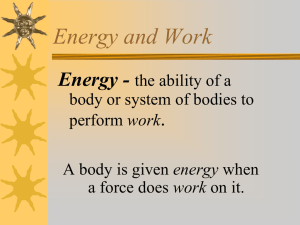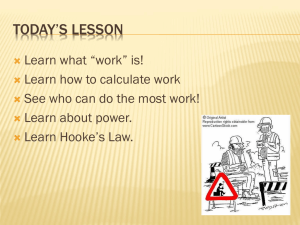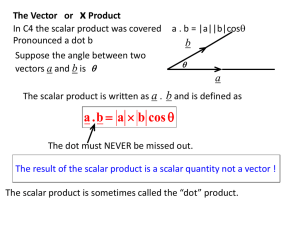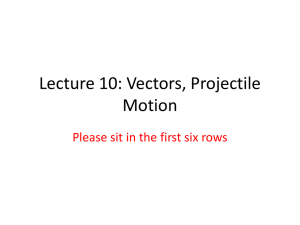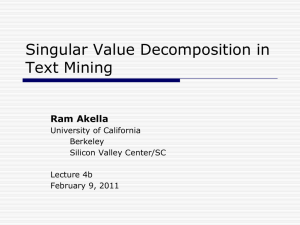Transformations
advertisement
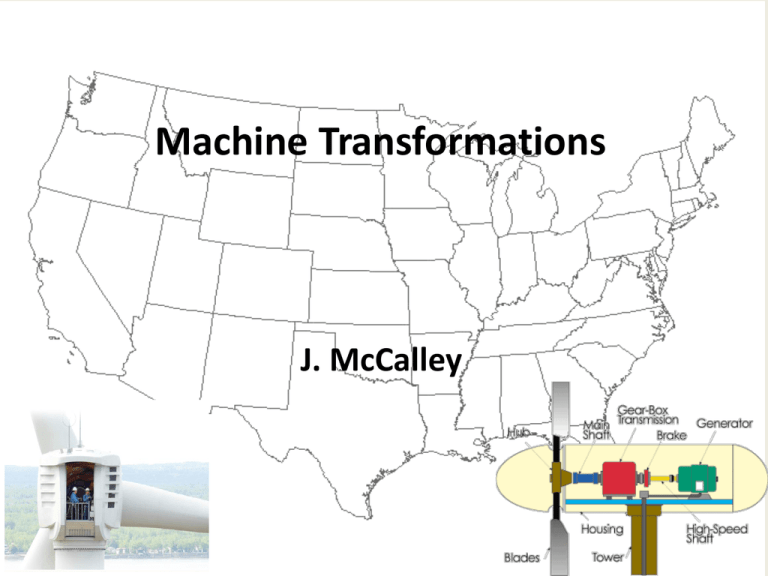
Machine Transformations J. McCalley Space vectors Consider a 2-pole induction machine with the a-phase stator winding, having Na turns, is distributed about its axis as shown below. The conductor density of the phase a winding is Na sin 2 where a negative density is interpreted as the return path of the turns. na 2 Space vectors If the coil carries a current ia, then the magneto-motive force (MMF, the magnetic circuit analogue to voltage in an electric circuit) is given by an application of Ampere’s circuital law, which relates the intensity of a magnetic field to the current that produces it. F H dl J dA A Apply to the closed path shown in the figure: Fa na ia d N a ia sin d 2 N a ia cos 3 Space vectors Symmetry allows us to associate half of this path mmf with each side of the machine. Thus, the mmf per airgap is N s ia Fa cos 2 Because this and other variables are distributed around the air-gap periphery, it is convenient to represent them by space vectors. A space vector is represented by a complex number having • a magnitude equal to the peak amplitude of the variable and • an angle equal to the angular position of this positive peak value. Each space vector is considered to have a cosinusoidal distribution around the machine periphery. The MMF space vector is denoted Fa We may also denote the current as a space vector: Na Thus, F a ia 2 ia 4 Space vectors Symmetry allows us to associate half of this path mmf with each side of the machine. Thus, the mmf per airgap is N s ia Fa cos 2 Because this and other variables are distributed around the air-gap periphery, it is convenient to represent them by space vectors. A space vector is represented by a complex number having • a magnitude equal to the peak amplitude of the variable and • an angle equal to the angular position of this positive peak value. Each space vector is considered to have a cosinusoidal distribution around the machine periphery. The MMF space vector is denoted Fa We may also denote the current as a space vector: Na Thus, F a ia 2 ia 5 Space vectors The two space vectors corresponding to F and i are illustrated below. 6 Space vectors We may go through the same procedure for the phase currents b and c, in which case we represent them with space vectors ib ic Define a positive rotation of 2π/3 as: a e Then a positive rotation of 4π/3 is: a 2 j ( 2 / 3) e j ( 4 / 3 ) 1 3 j 2 2 1 3 j 2 2 Because the b and c phase windings are spatially displaced from the a phase winding by 120 and 240 degrees, respectively, then: i b a ib i c a 2ic The total effect of a set of instantaneous currents in all three phase windings is then found by vector addition according to: i i a ib ic This is not the same as the sum of the currents: ia+ib+ic, which is zero! 7 Space vectors Time-domain waveforms Space vectors and their summation for the “instant” indicated on the other plot Observe: at the “instant,” ia is positive and just after its peak, ib and ic are negative. i i a i b i c ia aib a 2ic 8 Space vectors Let’s add them mathematically: i i a i b i c ia aib a 2ic Now use: a e j ( 2 / 3) 1 3 j 2 2 a 2 e j ( 4 / 3 ) 1 3 j 2 2 And we obtain: 1 1 3 3 ic i ia j ib j 2 2 2 2 ia 1 ib ic j 3 ib ic 2 2 But ia+ib+ic=0ia=-(ib+ic). Making this substitution in the above results in: i ia 1 3 ib ic 3 ia j 3 ib ic ia j 2 2 2 2 9 Space vectors i 3 3 ib ic ia j 2 2 It will be convenient for us later on to scale this vector by 2/3 resulting in : 2 3 3 3 ib ic i j i i i j a b c a 3 2 2 3 1 ib ic ia j 3 is The above relation concentrates the effects of the three phase currents into a single complex variable. Very nice! Now, let’s consider the converse process…. 10 Space vectors The converse process…. Consider that we know the space vector i s and that we want to find the instantaneous values of the individual phase currents. How to do this? We will project the vector i s onto the respective a, b, and c axes, as shown below. The analytic equivalent of this projection is: Just take the real part of i s ia Re i s Rotate the is vector forward by 240°. This places +b-axis where the +a-axis was. Then take real part. ib Re a 2 i s Rotate the is vector forward by 120°. This places +c-axis where the +a-axis was. Then take real part. ic Re a i s 11 Space vectors We have represented the phase currents as space vectors. In doing so, however, the only thing required was they were balanced three-phase quantities. Any other variables can be similarly represented as long as they are balanced three-phase quantities, e.g., currents, voltages, and fluxes. Let’s generically refer to any such variables as xa, xb, and xc and the corresponding space vector as x s 12 α-β transformation The space vector x s can also be represented by two “phase magnitudes,” called xα and xβ in the real-imaginary complex plane, as illustrated below. We can express this relationship mathematically according to: x s x jx 2 xa axb a 2 xc 3 The α-β components of the space vector can be calculated from the abc magnitudes according to: 2 1 1 x Re x s xa xb xc 3 2 2 13 Real part of axb Real part of a2xc x Im x s Im part of axb 2 3 3 x xc b 3 2 2 Im part of a2xc α-β transformation 2 3 3 x Im x s xb xc 3 2 2 These two relations can be represented in matrix form as follows: 1 1 x a 1 x 2 2 2 x b x 3 3 3 0 x 2 2 c 2 1 1 x Re x s xa xb xc 3 2 2 We define the matrix as the T-matrix: 1 1 2 2 T 3 3 0 2 This transformation is also called the “Clarke transformation” for the person who developed it, Edith Clarke. 14 1 2 3 2 February 10, 1883 - October 29, 1959 AT&T, MIT, GE, U-Texas α-β transformation 2 1 1 x Re x s xa xb xc 3 2 2 2 3 3 x Im x s xb xc 3 2 2 We will often represent the Clarke transformation in one of the two equivalent ways: 15 α-β transformation 2 1 1 x Re x s xa xb xc 3 2 2 2 3 3 x Im x s xb xc 3 2 2 It is interesting to observe, in a balanced system, so that xa+xb+xc=0, 2 1 x Re x s xa xb xc 3 2 2 1 23 xa xa xa xa 3 2 32 We can solve for xb and xc in terms of xα and xβ, in which case we obtain the inverse Clarke transformation as xa 1 x 1 b 2 xc 1 2 16 0 3 x 2 x 3 2 α-β transformation xa 1 x 1 b 2 xc 1 2 0 3 x 2 x 3 2 We often represent the inverse Clark transformation in two equivalent ways: 17 Other transformations When we transform variables to the α-β transformation we have just established, we are said to be working in the Stator Reference Frame. This reference frame is aligned with the stator, and the rotational speed of this reference frame, since it is aligned with the stator, is 0. The space vector referred to it rotates at the synchronous speed ωs. We denote the corresponding space vector with a superscript “s” (stationary) according to: s x x jx We can also define a space vector aligned with the rotor. The reference frame in this case is called the D-Q reference frame and it rotates with angular speed of ωm. Therefore the space vector referred to it rotates at the slip speed of ωr. r x xD jxQ Finally, we can also define a space vector aligned with the synchronous reference frame, at a speed of ωs. The space vector referred to it does not rotate, that is, it presents constant real and imaginary parts. This is called the d-q frame. a x xd jxq 18 Other transformations 19 Reference frame transformations Our objective now is to represent balanced, but time-varying (dynamic) behavior of a DFIG. There will be three types of equations that we will need: • Voltage equations • Flux linkage equations • Motion equations 20 Revolving rotor with constant flux Consider the rotating magnetic field (or a sinusoidal traveling wave) of an air gap, i.e., the plot on the left of the below figure and how it “moves” with time for a revolving rotor with constant flux (like that of a synchronous machine rotor). We see that, for fixed time (just one of the plots), there is sinusoidal variation of flux density with space. Also, if we stand on a single point on the stator (e.g., θ=90°) and measure flux (or flux density) as a function of time, we see that for fixed space (the vertical dotted line at 90°, and the red eye on the pictures to the right), there is sinusoidal variation of flux density w/time. θ N θ We can show that 3-phase, balanced currents of 3 stator windings separated by 120 degrees achieve the same thing. Let’s look at that…. 0 θ θ N θ θ N θ=90° 21 Rotating magnetic field Consider the 3-phase currents developed in the stator windings concentrated at points along the stator circumference 120 degrees apart. The currents are given by: ia I coss t ib I cos(s t 120) ic I cos(s t 240) Whenever we have a current carrying coil, it will produce a magnetomotive force (MMF) equal to Ni. (MMF is the magnetic circuit analogue to voltage in an electric circuit.) And so each of the above three currents produce a time varying MMF around the stator. Each MMF has a maximum in space, occurring on the axis of the phase, of Fam, Fbm, Fcm, expressed as Fam (t ) Fm coss t NI coss t Fbm (t ) Fm cos(s t 120) NI cos(s t 120) (*) Fcm (t ) Fm cos(s t 240) NI cos(s t 240) Define the angle θ as measured from the a-phase axis, and consider points in the airgap. At any time t, the spatial maximums expressed above occur on the axes of the corresponding phases and vary sinusoidally with θ around the air gap. We can combine the time variation with the spatial variation in the following way: Each individual phase MMF here varies with θ around the air gap and has an amplitude that varies with time. Fa ( , t ) Fam (t ) cos Fb ( , t ) Fbm (t ) cos( 120) Now substitute (*) into Fc ( , t ) Fcm (t ) cos( 240) these equations…. 22 Rotating magnetic field Fa ( , t ) Fm coss t cos Fb ( , t ) Fm cos(s t 120) cos( 120) Fc ( , t ) Fm cos(s t 240) cos( 240) Now add the three MMFs above: F ( , t ) Fa ( , t ) Fb ( , t ) Fc ( , t ) Fm coss t cos Fm cos(s t 120) cos( 120) Fm cos(s t 240) cos( 240) Use cosαcosβ=0.5[cos(α-β)+cos(α+β)] and then simplify, and you will obtain: F ( , t ) 3 Fm cos( s t ) 2 If we plot the above along the airgap, we will see exactly the same MMF distribution that was created by the revolving rotor with constant flux. 23 Space vectors F ( , t ) 3 Fm cos( s t ) 2 24

